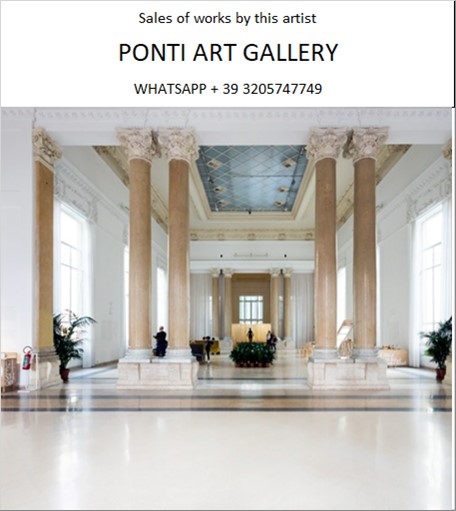Ponti Art Gallery is interested in buying and selling works
of art by this artist.

Le Pho Biography
Lê Phổ, born on August 2, 1907, in Hanoi, Vietnam, emerged as a pivotal figure in the fusion of Eastern and Western artistic traditions, creating a unique and enduring legacy in the world of art. His journey from the vibrant landscapes of Vietnam to the bustling art scene of Paris marked him as one of the most influential Vietnamese painters of the 20th century, whose works continue to captivate audiences worldwide.
Lê Phổ's early life was steeped in the rich cultural heritage of Vietnam. His father, Lê Hoan, was a senior mandarin in the French colonial government, which provided Lê Phổ with a privileged upbringing that included a comprehensive education. This background laid the foundation for his artistic pursuits, as he received training in traditional Vietnamese brush painting from a young age. His talent was evident early on, and he was encouraged by his family to pursue a career in art.
In 1925, Lê Phổ's artistic journey took a significant turn when he enrolled at the École des Beaux-Arts de l'Indochine in Hanoi. This institution was pivotal in shaping the future of Vietnamese art, as it introduced students to Western artistic techniques while encouraging them to retain their cultural identity. Lê Phổ thrived in this environment, studying under French artist Victor Tardieu, who had a profound influence on his development as an artist. Tardieu's appreciation for Vietnamese culture and his emphasis on combining Eastern subjects with French methodologies resonated with Lê Phổ, shaping his unique artistic voice.
Lê Phổ's talent and dedication earned him a scholarship to study at the École des Beaux-Arts in Paris, where he further honed his skills under the tutelage of Victor Tardieu. His time in Paris was marked by extensive travels across Europe, exposing him to the works of Renaissance masters and deepening his understanding of Western art. This period was crucial in the evolution of Lê Phổ's style, as he began to merge the impressionistic and surrealistic influences of the West with the traditional themes and techniques of Vietnamese art.
Upon returning to Vietnam, Lê Phổ took up a teaching position at his alma mater in Hanoi, where he continued to explore and refine his artistic vision. However, the political turmoil in Vietnam and his desire for artistic freedom led him back to Paris in 1937. There, he established himself as a prominent figure in the art world, holding his first solo exhibition in 1938. This marked the beginning of a celebrated career that spanned several decades and saw Lê Phổ's work exhibited in prestigious galleries across Europe and the United States.
Lê Phổ's oeuvre is characterized by its diversity and depth, reflecting his mastery of various mediums and styles. His early works, painted on silk, capture the serene beauty of Vietnamese landscapes and the grace of its people. As his style evolved, Lê Phổ began to experiment with oil on canvas, adopting bolder colors and more robust brushstrokes. His paintings from this period often feature idyllic scenes of women in traditional ao dai dresses, surrounded by lush flora, embodying a harmonious blend of Eastern aesthetics and Western technique.
Throughout his career, Lê Phổ's work underwent several transformations, reflecting his continuous exploration and adaptation of new influences. His art is often divided into three distinct periods: the Hanoi period, characterized by nostalgic landscapes; the Romanet period, marked by a focus on still lifes and mother-child themes; and the Findlay period, which showcased his interest in flattened spatial perspectives and expressive color.
Lê Phổ's legacy extends beyond his contributions to the art world. He was a pioneer in bridging the gap between Eastern and Western art, creating a body of work that resonates with universal themes of beauty, harmony, and the human condition. His paintings continue to be highly sought after by collectors and are held in prestigious collections worldwide. Lê Phổ passed away on December 12, 2001, in Paris, but his art remains a testament to his extraordinary talent and his enduring impact on the world of art.
Le Pho Quotes and Sales of
Works
Ponti Art Gallery selects and deals with paintings by the
artist. Upon request, we provide free estimates and
evaluations, communicate prices, quotations, and current
market values.
If you are interested in BUYING or SELLING works by the
artist, contact us immediately.
If you wish to sell or receive an evaluation of the
works:
Send us a frontal photo of the painting, one of the back,
and one of the signature. Also, indicate the dimensions of
the work. Inform us about the purchase origin of the work
and any kind of available documentation (purchase
receipts, certificates of authenticity, publications). One
of our operators will respond to you on the same day. We
guarantee maximum confidentiality and extreme
professionalism.
If you wish to purchase works by the painter: Contact us
and let us know your request. We will inform you about the
available works. We also offer the possibility to
subscribe to our NEWSLETTER, through which you will be
informed at the beginning of each month about the latest
acquisitions of the art gallery.
You can send us pictures of the work:
